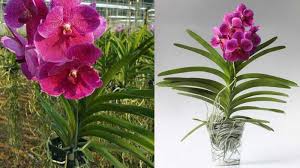# How to Know When to Prune Dendrobium Orchids: A Comprehensive Guide

Dendrobium orchids, belonging to one of the largest genera of orchids, are renowned for their stunning flowers and ease of care. One of the essential aspects of maintaining these beautiful plants is knowing when and how to prune them. Proper pruning can encourage healthy growth, increase blooming, and keep your orchids looking their best. In this guide, we’ll explore the signs that indicate it’s time to prune your Dendrobium orchids and provide step-by-step instructions for effective pruning techniques.
## 1. Understanding the Growth Habits of Dendrobium Orchids
### 1.1 Overview of Dendrobium Orchids
Dendrobium orchids encompass over 1,800 species, showcasing a wide range of colors, shapes, and growth habits. They are native to various regions, particularly Southeast Asia, and can thrive in diverse environments. Understanding the specific growth habits of your Dendrobium variety is essential for effective pruning.
### 1.2 Growth Phases
Dendrobium orchids typically go through several growth phases:
– **Vegetative Growth**: This phase involves the development of new leaves and stems, usually occurring in spring and summer.
– **Flowering Phase**: After adequate vegetative growth, Dendrobium orchids will enter their flowering phase, which can last several weeks.
– **Dormancy**: Following blooming, many Dendrobium species enter a dormant phase, during which growth slows, and the plant conserves energy.
Recognizing these phases is vital for determining the best times to prune your orchids.
## 2. When to Prune Dendrobium Orchids
### 2.1 Post-Bloom Pruning
One of the most common times to prune Dendrobium orchids is after they have finished blooming. This practice helps to remove dead or spent flower spikes and encourages new growth.
**Signs It’s Time to Prune After Blooming**:
– **Faded Flowers**: Once the flowers have wilted and turned brown, it’s time to prune the flower spike.
– **Drying Flower Spike**: If the spike has dried up and turned brown, cut it back to the base.
### 2.2 During the Growing Season
Pruning can also occur during the active growing season (spring and summer). This can involve trimming back leggy growth or unhealthy leaves to promote a more compact and robust plant.
**Signs It’s Time to Prune During Growth**:
– **Leggy Growth**: If your orchid has elongated stems with sparse leaves, pruning back these leggy sections can encourage bushier growth.
– **Yellowing or Diseased Leaves**: Remove any yellowing or damaged leaves to improve overall plant health.
### 2.3 Pre-Dormancy Pruning
Just before entering dormancy, some growers choose to prune their orchids lightly. This can help prepare the plant for rest and promote better growth in the next cycle.
**Signs It’s Time to Prune Before Dormancy**:
– **End of the Growing Season**: As temperatures cool and growth slows, a light prune can be beneficial.
– **Assessment of Plant Health**: If your Dendrobium appears weak or unhealthy, a pre-dormancy prune can help redirect energy to stronger parts of the plant.
## 3. Tools Needed for Pruning
Before starting the pruning process, gather the necessary tools to ensure a clean and effective cut:
– **Sterilized Pruning Shears**: Sharp, clean shears are crucial for making precise cuts without damaging the plant. Sterilizing helps prevent the spread of diseases.
– **Rubbing Alcohol or Bleach**: Use these for sterilizing your tools before and after use.
– **Gloves**: Protect your hands from sap and potential irritants.
## 4. How to Prune Dendrobium Orchids
### 4.1 Step-by-Step Pruning Process
#### Step 1: Assess the Plant
Take a close look at your Dendrobium orchid. Identify any dead or dying flowers, leaves, or stems that require removal. Note areas where growth seems weak or leggy.
#### Step 2: Prepare Your Tools
Sterilize your pruning shears with rubbing alcohol or bleach. This prevents any potential diseases from infecting your orchid.
#### Step 3: Remove Dead or Dying Spikes
Using your sterilized shears, carefully cut back flower spikes that have wilted and turned brown. Always cut the spike at the base, near the stem, to encourage new growth.
#### Step 4: Trim Leggy Growth
For any elongated or weak stems, trim them back to a healthy leaf node. Cutting just above a node encourages new growth from that point.
#### Step 5: Remove Yellowing or Damaged Leaves
If you notice any yellow or damaged leaves, prune them at the base. This helps improve air circulation and redirects energy to healthier parts of the plant.
#### Step 6: Clean Up
Dispose of the cuttings and clean your tools once more to prevent disease spread. Ensure your growing area is tidy to avoid pest infestations.
### 4.2 Post-Pruning Care
After pruning, provide your Dendrobium orchids with proper care to encourage recovery:
– **Watering**: Ensure your orchids are adequately watered, but avoid overwatering. Allow the potting medium to dry out slightly before the next watering.
– **Light**: Maintain appropriate light levels to support new growth.
– **Fertilization**: Consider a balanced fertilizer after pruning to promote healthy regrowth.
## 5. Signs of Stress After Pruning
While pruning is essential for plant health, it can also stress your orchids if done improperly. Here are signs of stress to watch for:
– **Wilting Leaves**: This may indicate that the plant is not receiving enough water or light.
– **Yellowing Leaves**: A sign of potential over-fertilization or water issues.
– **Lack of New Growth**: If your orchid fails to produce new growth within a few weeks, it may be stressed from improper pruning.
If you observe any of these signs, reassess your care regimen to provide optimal conditions for recovery.
## 6. Best Practices for Pruning Dendrobium Orchids
### 6.1 Regular Monitoring
Regularly monitor your Dendrobium orchids to catch any issues early. A well-cared-for orchid will exhibit healthy growth and vibrant blooms.
### 6.2 Timing is Key
Always aim to prune during the appropriate growth phases. Avoid heavy pruning during the peak growing season or immediately after blooms to minimize stress.
### 6.3 Learn from Experience
Every Dendrobium orchid is unique. Over time, you’ll learn how your plants respond to pruning and when they thrive best. Keep a care journal to track your observations and adjust your practices accordingly.
## 7. Understanding Dendrobium Orchid Varieties
### 7.1 Types of Dendrobium Orchids
Different species of Dendrobium orchids have varying growth habits and flowering cycles. Understanding these differences can help tailor your pruning approach:
– **Dendrobium Nobile**: This species produces flower spikes from old growth. Pruning should occur after blooming.
– **Dendrobium Phalaenopsis**: This variety blooms on new growth. Light pruning can occur throughout the growing season to promote bushier growth.
### 7.2 Research Your Specific Species
Before pruning, familiarize yourself with the specific needs and growth patterns of your Dendrobium variety. Online resources, books, and local orchid societies can provide valuable insights.
## 8. The Role of Environmental Factors
### 8.1 Light Conditions
Light levels can affect how and when you prune your orchids. Ensure that your orchids are receiving adequate light before and after pruning to support healthy regrowth.
### 8.2 Temperature and Humidity
Dendrobium orchids prefer specific temperature and humidity levels. High humidity and consistent temperatures can help minimize stress after pruning.
### 8.3 Seasonal Changes
Recognize how seasonal changes affect your orchids. During the winter, growth slows, making it an unsuitable time for heavy pruning. Instead, focus on light maintenance during dormancy.
## 9. Common Pruning Mistakes to Avoid
### 9.1 Over-Pruning
Avoid removing too much of the plant at once. Excessive pruning can lead to stress and poor growth. Always prioritize gentle trimming over aggressive cutting.
### 9.2 Neglecting Sterilization
Failing to sterilize your tools can introduce diseases to your orchids. Always take the time to clean your equipment before and after use.
### 9.3 Ignoring Plant Health
Before pruning, assess the overall health of your Dendrobium orchids. Prune only when the plant is healthy and actively growing to minimize stress.
## 10. Conclusion
Pruning Dendrobium orchids is a vital part of their care regimen. By understanding the right times to prune, using proper techniques, and monitoring your plants’ health, you can ensure vibrant blooms and healthy growth. Remember to be patient and attentive, as each orchid has its unique needs and growth patterns. With the right care, your Dendrobium orchids will thrive and continue to bring beauty to your home. Happy gardening!

